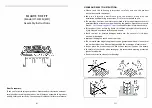
48
INLET TAP
OUTLET TAP
LP GAS PRESSURE REQUIREMENTS
Inlet and manifold gas pressure checking taps are located on gas valve. These ports are only accessible from the outer left
side of the fireplace. A qualified installer shall take pressure measurements at these ports to verify and set the correct gas
pressures during the LP Kit installation and before fascia materials are installed over the front of this fireplace. Manifold
pressure must
be taken at the “MANIFOLD PRESSURE" tap and inlet pressure at the "INLET PRESSURE" tap
with the
burner
operating
by a qualified installer.
DESIRED
INLET
PRESSURE
MINIMUM
INLET
PRESSURE
MAXIMUM
INLET
PRESSURE
MANIFOLD
OUTLET
PRESSURE
AIR SHUTTER
POSITION
L.P. GAS
11.0" W.C
.
(2.75 kPa)
11" W.C.
(2.75 kPa)
13.0" W.C.
(3.24 kPa)
10.0" W.C.
(2.5 kPa)
1/4" OPEN MIN.
(5 mm)
REGULATE THE FLAME HEIGHT TO "HIGH" POSITION. OUTLET GAS PRESSURES MAY VARY PLUS OR MINUS 5%.
LPG PROPER INPUT RATES
With the proper orifices installed, as specified above,
this fireplace utilizing LP Gas will have a maximum
input rate of 31,000 Btu/Hr.
LEAK TESTING REQUIREMENTS
Prior to completing the conversion process, check for
gas leaks with soap and water solution at all plumbing
joints prior to placing this appliance into operation. It
is recommended that all gas-plumbing joints, factory
installed and field installed are checked for leaks.
PILOT FLAME AND MAIN BURNER RELATIONSHIP
VERIFICATION
Prior to completing the conversion process, the qualified service technician must,
light the pilot light and verify the relationship between the pilot light flames and the
main burners. The pilot light flames directed towards the propagation ports on the rear and front burner must overlap the
propagation ports on the burners. The pilot light flames must be a minimum of ¾” long and must overlap the propagation
ports on both the rear and front burners as shown in the diagram, below. Verify that the burner tubes ignite quickly and the
burner flames propagate smoothly along the entire length of the burners.
PILOT FLAME LENGTH ADJUSTMENT
If the pilot light flame length is too short and the system does not maintain a standing pilot, a qualified installer may in-
crease the length of the pilot light flames to meet the two requirements: Minimum pilot light length to maintain a standing
pilot light and the pilot light flames must be long enough to overlap the front and rear burner ports, 1 inch long minimum.
CHECKING FOR NORMAL BURNER(S) IGNITION CHARACTERISTICS
Once the conversion to LPG and all the above steps have been completed, light the main burners.
Turn Gas Dial counterclockwise to "ON" then set Thermostat or push Main Burner ON/OFF switch to turn on burners.
Main burner should now light IMMEDIATELY and flame should not "lift" off burner. If there is any delay in ignition or if
flame is "lifting off" burner, turn off burner and carefully check for proper installation of logs/coals, vent system and proper
pilot flame impingement on burner and thermopile. Logs or coals must not block pilot flame or main burner flame. Vent
system must be leak proof.
GAS LEAK TEST REQUIREMENT
:
It is the responsibility of the installer/service person to assure that each and
every gas connection and supply tubing that are a part of this fireplace are leak proof. The qualified/ certified individual
connecting the gas supply line, performing pressure tests or performing any service to this fireplace is required to perform
a THOROUGH LEAK TEST on ALL gas fittings that are a part of this appliance or the gas supply line connection using
soap-water solution or a calibrated combustible gas detector. Failure to perform this leak test may lead to a house fire
and/or an explosion. Mendota is not responsible for any damages due to an Installer’s failure to conduct a leak test and
verify that all connections and supply lines are leak proof.
WARNING:
Do not operate appliances with glass front removed, cracked, or broken. Replacement of glass should be
done a licensed or qualified service person.
Figure 6: Pressure Test Port







































